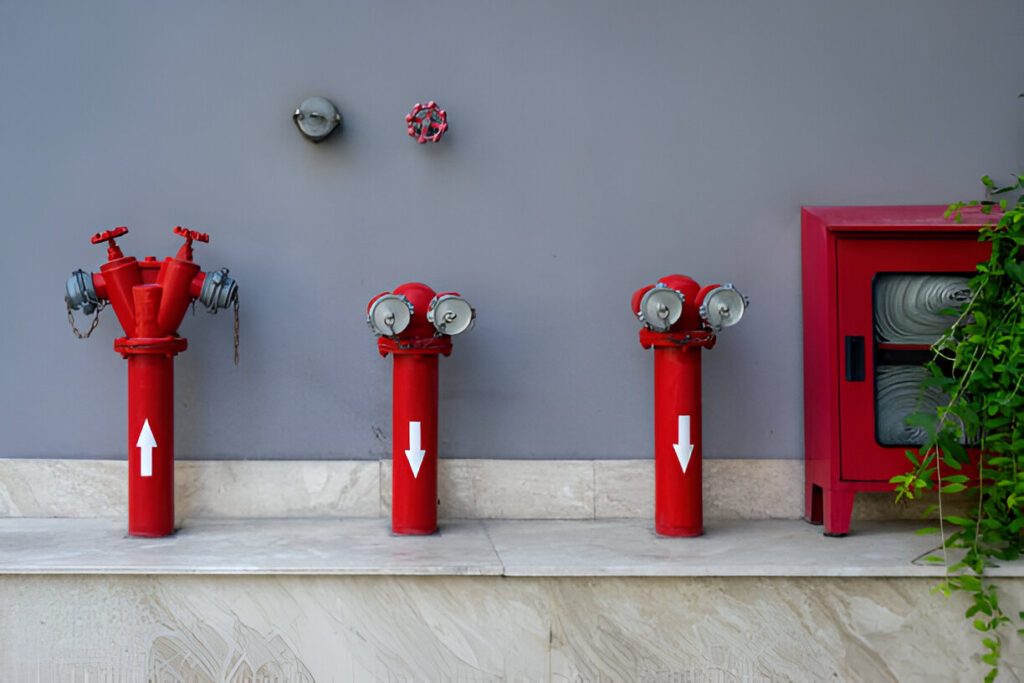Fire Hydrant System Design, Installation and Maintenance
The design, installation, and maintenance of fire hydrant systems in the UAE follow stringent regulations set by the UAE Civil Defense and align with international standards such as NFPA 24 and UAE Fire and Life Safety Code of Practice.

Design of Fire Hydrant Systems in the UAE
Regulatory Compliance
- Design must meet the standards outlined in the UAE Fire and Life Safety Code.
- Obtain Civil Defense approval before proceeding with installation.
System Components
- Hydrants: Typically placed in accessible outdoor areas for use by firefighting personnel.
- Piping: Underground ductile iron or HDPE pipes are common in UAE due to their durability in harsh climates.
- Pumps and Water Tanks: Fire pumps (diesel or electric) are used alongside water tanks to ensure uninterrupted supply, especially in high-rise buildings and remote areas.
- Valves and Accessories: Isolation valves, pressure relief valves, and backflow prevention devices.
Design Considerations
- Water Flow and Pressure: Systems must provide a minimum flow of 250 GPM with a residual pressure of 7 bar, as per UAE Civil Defense requirements.
- Spacing and Accessibility: Fire hydrants should be spaced every 30-50 meters and located at strategic points for quick access.
- Climatic Factors: Components should withstand the extreme temperatures and sandstorms prevalent in the UAE.
Hydraulic Calculations
- Ensure adequate pressure and flow by accounting for pipe friction losses, elevation differences, and the required firefighting capacity.
Integration with Other Systems
- Fire hydrant systems are often integrated with building fire sprinkler systems for comprehensive coverage.
Installation of Fire Hydrant Systems in the UAE
Fire hydrant system installation in the UAE must follow Civil Defense-approved designs and involve licensed contractors. Key steps include
Pre-Installation Approvals
- Obtain necessary permits and approvals from the local Civil Defense authority.
Site Preparation
- Conduct a site survey to identify optimal locations for hydrants and underground pipelines.
- Ensure the area is free of obstructions and conforms to accessibility requirements.
Equipment Installation
- Install fire hydrants, pipes, valves, and fittings as per the approved design.
- Use corrosion-resistant materials to combat the UAE’s high humidity and salinity levels.
Pumps and Tanks
- Position fire pumps and water tanks in accordance with NFPA 20 and UAE regulations.
- Ensure diesel pumps are equipped with a backup power source.
Testing and Commissioning
- Conduct hydrostatic pressure tests, flow tests, and operational tests in the presence of Civil Defense representatives.
- Submit test results and obtain a completion certificate from Civil Defense.
Maintenance of Fire Hydrant Systems in the UAE
Regular maintenance is critical for compliance and ensures operational readiness during emergencies. Maintenance practices in the UAE include:
Periodic Inspections
- Conduct monthly visual inspections of hydrants, pipes, and valves.
- Verify that hydrants are free of obstructions and clearly marked.
Testing
- Perform flow and pressure tests annually or as required by Civil Defense.
- Operate hydrants to ensure valves open and close smoothly without leaks.
Environmental Considerations
Clean hydrants and pipelines to remove sand and debris that can accumulate in UAE’s desert environment.
Pump Maintenance
- Test fire pumps monthly and ensure diesel pump fuel levels are adequate.
- Check for wear, lubrication needs, and electrical connections.
Recordkeeping
- Maintain detailed logs of inspections, testing, and repairs for Civil Defense audits.
- Schedule annual maintenance contracts with approved service providers.
Adhering to UAE Civil Defense regulations is mandatory for all fire hydrant systems. Key compliance steps include:
- Submitting design plans for approval before installation.
- Using Civil Defense-approved materials and contractors.
- Scheduling regular inspections and maintenance by licensed professionals.
